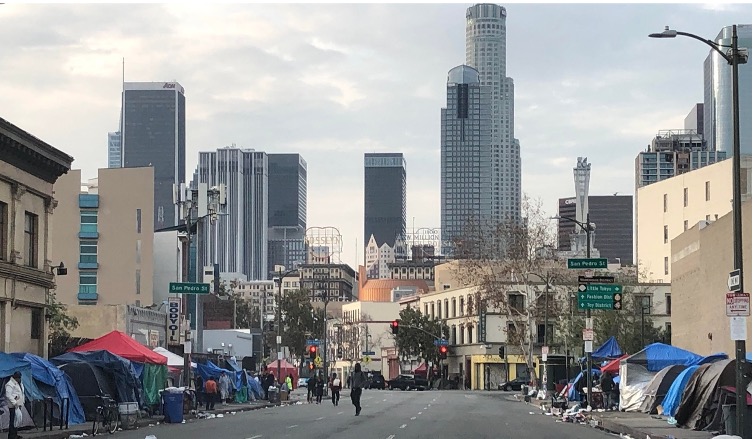CommentsPLANNING WATCH - Last week’s Planning Watch column generated emails from readers wanting to know where I stood on LA’s Mayoral election, in particular because the column led with a critical LA Times question about Karen Bass’s homeless policies.
So, let me clear up any confusion. Based on what I write about – homelessness, planning, zoning, climate change, urban forest, infrastructure, public services, and City Hall pay-to-play – I don’t think any mayoral candidates can guide LA out of its multiple crises.
This is why I wrote two previous columns explaining why the mayoral candidates do not and cannot effectively address LA multiple crises, especially climate change and homelessness. But, despite my skepticism about a Tinseltown hero riding into Dodge to turn things around, there are still many opportunities for the public to engage in successful non-electoral political actions:
- Neighborhood and citywide activism, such as environmental and anti-eviction protests.
- Lawsuits, such as those that Fix the City initiated against the City of Los Angeles for the Hollywood Community Plan and the Transit Oriented Development Guidelines.
- Exposés of City Hall financial skullduggery, like those in
- Citywide voter initiatives, such as the proposed United to House LA initiative that would place a larger transaction fee on houses worth more than $5,000,000.
Democracy is much more than elections, especially those in which major candidates are largely funded by special interests and offer voters a narrow range of views. This is why we need to pursue the other democratic options I listed above. In the meantime, however, electoral campaigns can be used for long-term non-electoral political organizing. Better to have an organizational infrastructure in place than building it from scratch at a moment’s notice. Plus, if or when decent candidates emerge, like City Attorney candidate Hydee Feldstein-Soto, the voting option will be ready to go.
This said, some e-mailers wondered why is it so difficult for candidates and public officials to understand and deal with the homeless crisis? If a retired city planner, like me, can figure it out and share the answer in a free on-line publication, candidates with full access to professional investigators and researchers should have no problem doing the same. But since they don’t, we need to figure out what (self-imposed?) barriers stand in their way.
Part of the explanation is in the historical record. In the early 1930s the City of Los Angeles built and operated its own public housing. These projects and programs were gradually assumed by the Federal Housing Administration beginning in 1934 and continued on a relatively smooth trajectory until the Nixon administration (1968-1974)
The highwater mark was the Housing Act of 1949, bi-partisan legislation sponsored by Republican Senator Robert Taft and Democratic Senators Allen Ellender and Robert Wagner, as part of President Truman’s Fair Deal. This legislation funded 800,000 units of public housing, premised on the New Deal’s still-valid rationale. The private sector is unable to build and operate low cost housing, and therefore the Federal government must fill the void for those whose low incomes price them out of private sector housing.
After Congress eliminated HUD public housing programs, in California the remaining source for public housing funding was the state's 400 Community Redevelopment Agencies. But Sacramento dissolved them in 2011. Since then new low cost housing has been wholly privatized, with meager results. Hardly any new low cost housing is being built, rented to vetted low-income tenants, and inspected.
Nevertheless, nationwide over a million people still live in legacy public housing. If HUD and CRA public housing programs had not been cancelled, there would be another million units of public housing. This is considerably more than the 600,000 plus homeless people in the United States.
But the unsuccessful privatization of low-priced housing programs was not based on valid claims that public housing had failed. In fact, Los Angeles has examples of public housing that is successful, such as the senior towers on Bunker Hill, Chinatown, and Little Tokyo. Furthermore, the market-based private sector housing programs, such as up-zoning and Density Bonuses, have been total flops. This is obvious in neighborhoods, like Hollywood and Downtown LA, where new upscale apartments are, like nearby mushrooming homeless encampments, totally transforming these areas.

DTLA: Mushrooming homeless encampments near new high-rise buildings.
The reason is the need for private developers, whose viewpoints dominate planning circles, mainstream media, and both major political parties, to expand the locations available for their speculative housing investments. This is why both Democrats and Republicans call for removing “bureaucratic barriers” to housing construction, a supply-side neo-liberal approach that results in McMansions and luxury apartments, even though their construction aggravates the housing crisis. The unintended outcome of this policy, increasing homelessness, is dismissed as a cost of doing business best handled by the LAPD.
This is why candidates, elected officials, and their professional staff side with their benefactors, not those forced to live in overcrowded conditions or sleep on couches, streets, and sidewalks. Their inability to understand the housing crisis is self-imposed and based on opportunism, not because the underlying causes are too complex for mortals to possibly understand.
While there is little reason to expect them to voluntarily change their views, they are political animals. When faced with mounting political pressure from below, lawsuits, embarrassing exposes, and voter initiatives, they bend in the wind.
(Dick Platkin is a former Los Angeles city planner who reports on local planning issues for CityWatchLA. He serves on the boards of United Neighborhoods for Los Angeles (UN4LA) and the Greater Fairfax Residents Association. Previous Planning Watch columns are available at the CityWatchLA archives. Please send questions and corrections to [email protected].)
















